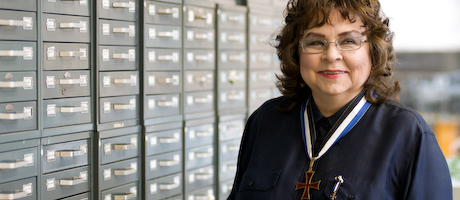By Menachem Wecker
Barbara von Barghahn still remembers receiving the phone call in 1993 informing her that then-Portuguese President Mário Soares would bestow on her one of Portugal’s highest civilian awards – the rank of knight commander in the Order of Prince Henry the Navigator.
“I was shocked,” says Dr. von Barghahn, professor of art history. “I had only worked on Portuguese art in depth in the decade before, so I was relatively new to that field.”
Aside from affording her the title Dama (Lady), a large silver cross-shaped pin and a ribbon and medal, membership in the order has helped Dr. von Barghahn maintain longstanding relationships with the embassies of Portugal, Spain and Belgium.
Though she says she was new to the field, Dr. von Barghahn had arranged two major conferences in the previous two years which drew top European and U.S. scholars on Spain and Portugal. The conferences, held in GW’s Marvin Center, were simultaneously translated into three languages and featured fiestas, banquets at the Portuguese and Spanish embassies, on-stage dancing, harpsichord playing and about a dozen keynote speakers.
President Soares and Felipe González Márquez, then-Spanish prime minister, opened one conference, and Mickey East, then-dean of the Elliott School of International Affairs, introduced the other. The Organization of American States, where Dr. von Barghahn sat on the museum board, was a co-sponsor.
Due to varying levels of support from the embassies, the 1991 conference was titled Spain and Portugal of the Navigators, while the 1992 conference switched the names – Portugal and Spain of the Navigators. “This is where diplomacy comes into play,” says Dr. von Barghahn.
Diplomacy is an area she knows intimately. Growing up, she wanted to work in international relations like her father, Joseph J. Barghahn, who was assigned to a variety of State Department posts, including serving as an economist in Latin America, program analyst in the Philippines and procurement officer in Japan and Israel.
Two months after Dr. von Barghahn was born in Washington, her family moved to Japan. Her first memories are of the family’s next home in Israel, where her father was one of seven Americans in the Israel mission under former President Harry Truman’s Point Four Program. Though he earned a doctorate in Japan and spoke Japanese fluently, Joseph Barghahn did not “manage to learn Hebrew in the two years he was in Israel,” according to an April 23, 1954 issue of the American Zionist newspaper Israel Speaks, though “his 5-year-old daughter, Barbara Ann, was speaking it fluently after three months.”
Despite her aptitude for languages – she reads and writes in seven languages today – Dr. von Barghahn ultimately chose a different career path from her father. “I was dismal in math,” she says. “I couldn’t pass the foreign service exam.”
After returning to Washington, the Barghahn family moved to northern Iran, where Dr. von Barghahn remembers mountainous areas, vineyards and 20-hour drives to Tehran along dirt paths. Returning to the United States after that came with a bit of culture shock. “I missed out on the 1950s and ’60s,” she says.
After enrolling as a pre-medicine student at the University of Iowa, where her parents thought she would be safe from the Vietnam protests in Washington, Dr. von Barghahn decided she did not like getting Bs in organic chemistry. She had received an A in art history, so she decided to switch majors.
Prince Henry earned his title of navigator by colonizing for the Portuguese crown in the 15th century, and Dr. von Barghahn also became an explorer of sorts. At New York University, where she earned a Ph.D., she was told that art history students were supposed to study Italy. Feeling that Spain and Portugal were unfairly neglected, she rebelliously picked them as a second major.
Just as Jan van Eyck, whom she calls the most important Flemish Renaissance master, reshaped his Ghent altarpiece with the flora he had seen on his extensive travels, Dr. von Barghahn draws from her years in Latin America and Western Africa in her research and teaching. “I think everyone is shaped by his or her travels,” she says.
“I love working with non-Americans and then communicating some of the best of their cultures to students,” she adds. “Some of the field of art history is just opening up now. More coverage is needed of areas like Norway, Denmark, Finland, Russia and Latin America.”
In her research, Dr. von Barghahn locates the meaning of works in their historical context – accenting the history part of art history. “I think it is really important to know what the work meant at the time rather than coming with 20th century preconceived notions,” she says.
This approach works particularly well in Washington and at GW, she says. “Being in D.C., you attract students from all walks of life.”
Dr. von Barghahn currently has a book accepted for publication which addresses van Eyck’s patrons, which prior scholarship had recognized as only Phillip the Good, duke of Burgundy. But Dr. von Barghahn found representations of Portuguese monarchs in copies of van Eyck works lost to a 1775 earthquake that destroyed a palace in Lisbon. Her thesis – that van Eyck’s Portuguese royals were just as important as Phillip the Good – tracks van Eyck’s travels in Bruges, Granada and Santiago de Compostela and also addresses the quest for the Holy Grail.
But even as she studies ancient and medieval art, Dr. von Barghahn is also fascinated by contemporary art. “I love photography,” she says, and she often uses photographs in her lectures provided by friends in Europe and South America.
Though older scholars often stick to slides, the next generation of historians will have to be able to create their own digitals, she says. “You cannot start young enough to create your own digital library.” Is she worried students too familiar with new media will not take the trek to see the originals? “No that was always an issue, even with slides.”


